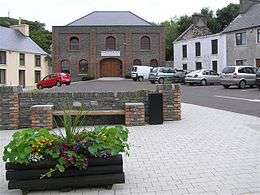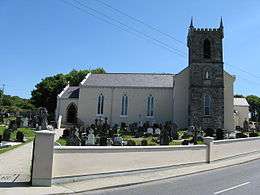Clonmany
| Clonmany Cluain Maine | |
|---|---|
| Town | |
 Clonmany Location in Ireland | |
| Coordinates: 55°15′45″N 7°24′45″W / 55.2625°N 7.4125°WCoordinates: 55°15′45″N 7°24′45″W / 55.2625°N 7.4125°W | |
| Country | Ireland |
| Province | Ulster |
| County | County Donegal |
| Government | |
| • Dáil Éireann | Donegal North-East |
| Area[1] | |
| • Total | 95.01 km2 (36.68 sq mi) |
| Population (2011) | |
| • Total | 4 |
| • Density | 0.042/km2 (0.11/sq mi) |
| Time zone | WET (UTC+0) |
| • Summer (DST) | IST (WEST) (UTC-1) |
| Area code(s) | 074, +353 74 |
| Irish Grid Reference | C374463 |
Clonmany (Irish: Cluain Maine) is a village in north-west Inishowen, in County Donegal, Ireland. The area has many local beauty spots, and the Ballyliffin area is famous for its golf course. The Urris area to the west of Clonmany village was the last bastion of the Irish language in Inishowen. In the 19th century, the area was a frequent location of poitín distillation (a strong Irish spirit).
Name
The name of the town in Irish - Cluain Maine has been translated as both "The Meadow of St. Maine" and "The Meadow of the Monks", with the former being the more widely recognised translation.

History
Although the village itself is the youngest in Inishowen, the Clonmany area is steeped in history, and dolmens, forts and standing stones dot the landscape. The parish was home to a monastery, closely associated with the Morrison family, who provided the role of erenagh. The monastery was home to the Míosach a copper and silver shrine, now located in the National Museum of Ireland in Dublin. Details of local history and traditions were recorded in "The Last of the Name", recorded by schoolteacher Patrick Kavanagh (NOT the poet) from stories by Clonmany local, Charles McGlinchey.
Climate
The location of Clonmany on the Inishowen peninsula, and bordering Lough Swilly with views of the Atlantic provides the Clonmany area with a moderate climate; with temperate,mild summers, and winters that rarely go below freezing. The average temperatures for the area are usually warmer than the national average in winter, and cooler than the national average in summer.

Education
Clonmany has four primary schools, Clonmany N.S. (with a new state of the art school), Scoil Naomh Treasa (also known as Tiernasligo N.S. locally), Scoil Phádraig at Rashenny, and Scoil na gCluainte, or Cloontagh National School. Most students from these schools go on to attend secondary level education at Carndonagh Community School in Carndonagh, with most of the remainder attending Scoil Mhuire or Crana College in Buncrana.
Transport
Clonmany railway station opened on 1 July 1901, but finally closed on 2 December 1935.[2]
Culture & Tourism
Clonmany is host to the annual McGlinchey summer school, which attracts many visitors to its exhibitions and lectures on local history. Another attraction is the Clonmany festival, held annually during the week of the Irish August public holiday. The Clonmany Agricultural Show and Sheepdog Trials takes place on the Tuesday of festival week, with visitors from all over Inishowen and the Northwest of Ireland.
See also
References
- ↑ Census 2002 - Volume 1: Population Classified By Area, Central Statistics Office, Dublin, 2003
- ↑ "Clonmany station" (PDF). Railscot - Irish Railways. Retrieved 2007-09-17.
